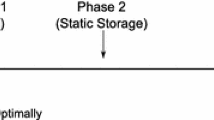Abstract
In a video-on-demand environment, continuous delivery of video streams to the clients is guaranteed by sufficient reserved network and server resources. This leads to a hard limit on the number of streams that a video server can deliver. Multiple client requests for the same video can be served with a single disk I/O stream by sending (multicasting) the same data blocks to multiple clients (with the multicast facility, if present in the system). This is achieved by batching (grouping) requests for the same video that arrive within a short time. We explore the role of customerwaiting time and reneging behavior in selecting the video to be multicast. We show that a first come, first served (FCFS) policy that schedules the video with the longest outstanding request can perform better than the maximum queue length (MQL) policy that chooses the video with the maximum number of outstanding requests. Additionally, multicasting is better exploited by scheduling playback of the n most popular videos at predetermined, regular intervals (hence, termed FCFS-n). If user reneging can be reduced by guaranteeing that a maximum waiting time will not be exceeded, then performance of FCFS-n is further improved by selecting the regular playback intervals as this maximum waiting time. For an empirical workload, we demonstrate a substantial reduction (of the order of 60%) in the required server capacity by batching.
Similar content being viewed by others
References
Anderson DP (1993) Metascheduling for continuous media. ACM Trans Comput Syst 11:226–252
Craig DW, Woodside CM (1990) The rejection rate for tasks with random arrivals, deadlines, and preemptive scheduling. IEEE Trans Software Eng 16:1198–1208
Dan A, Sitaram D (1993) Buffer management policy for an on-demand video server. IBM Research Report RC 19347, Yorktown Heights, NY
Dan A, Sitaram D (1995) A generalized interval caching policy for mixed interactive and long video environment. IBM Research Report RC 20206. To appear in MMCN 96
Dan A, Sitaram D, Shahabuddin P (1994) Scheduling policies for an on-demand video server with batching. IBM Research Report RC 19381
Dan A, Shahabuddin P, Sitaram D, Tetzlaff W (1994) Anticipatory scheduling with batching for video servesr. IBM Research Report RC 1 9640, Yorktown Heights, NY
Dan A, Dias D, Mukherjee R, Sitaram D, Tewari R(1995a) Buffering and caching in large-scale video servers. Proceedings of IEEE Comp-Con, San Francisco, CA, pp 217–224
Dan A, Kienzle M, Sitaram D (1995b) Dynamic segment replication policy for load-balancing in video-on-demand servers. ACM Multimedia Syst 3:93–103
Dan A, Shahabuddin P, Sitaram D, Towsley D (1995c) Channel allocation under batching and VCR control in movie-on-demand servers. Journal of Parallel and Distributed Computing vol 30, 168–179
Dykeman HD, Ammar MH, Wong JW (1986) Scheduling algorithms for videotex systems under broadcast delivery. Proceedings of IEEE ICC’86, Toronto, Canada, pp 1847–1851
Fox EA (1989) The coming revolution in interactive digital video. Commun ACM 7:794–801
Gelman AD, Halfin S (1990) Analysis of resource sharing in information providing services. Proceedings IEEE Global Telecommunications Conference and Exhibition, San Diego, CA, 1:312–316
Gross D, Harris CM (1985) Fundamentals of queueing theory. John Wiley, New York Chichester Brisbane Toronto Singapore, p 124
Kleinrock L (1975) Queueing systems, vol 1: theory. John Wiley, New York Chichester Brisbane Toronto, p 105
Le Boudec J-Y (1992) The asynchronous transfer mode: a tutorial. Comput Networks ISDN Syst 24:279–309
Lindfield GR, Penny JET (1989) Microcomputers in numerical analysis. John Wiley, New York Chichester Brisbane Toronto, p 31
Marchok DJ, Rohrs C, Schafer MR (1991) Multicasting in a growable packet (ATM) switch. IEEE INFOCOM, Bal Harbor, FL, pp 850–858
Peha JM, Tobagi FA (1990) Evaluating scheduling algorithms for traffic with heterogeneous performance objectives. IEEE GLOBECOM, pp 21–27
Rangan PV, Vin HM, Ramanathan S (1992) Designing an on-demand multimedia service. IEEE Commun Magazine 30:56–65
Sincoskie WD (19891) System architecture for a large-scale video-ondemand service. Comput Networks ISDN Syst 22:155–162
Stankovic J, Ramamritham K, Chang S (1985) Evaluation of a flexible task-scheduling algorithm for distributed hard real-time systems. IEEE Trans Comput C-34:1130–1143
Wolff RW (1989) Poisson arrivals see time averages. Operations Res 30: 223–231
Wong JW, Ammar MH (1985) Analysis of broadcast delivery in a videotex system. IEEE Trans Commun 34:863–866
Zhao ZX, Panwar SS, Towsley D (1991) Queueing performance with impatient customers. IEEE INFOCOM, Bal Harbor, FL, pp 400–409
Author information
Authors and Affiliations
Corresponding author
Additional information
This work was done at IBM Research
Rights and permissions
About this article
Cite this article
Dan, A., Sitaram, D. & Shahabuddin, P. Dynamic batching policies for an on-demand video server. Multimedia Systems 4, 112–121 (1996). https://doi.org/10.1007/s005300050016
Received:
Issue Date:
DOI: https://doi.org/10.1007/s005300050016




